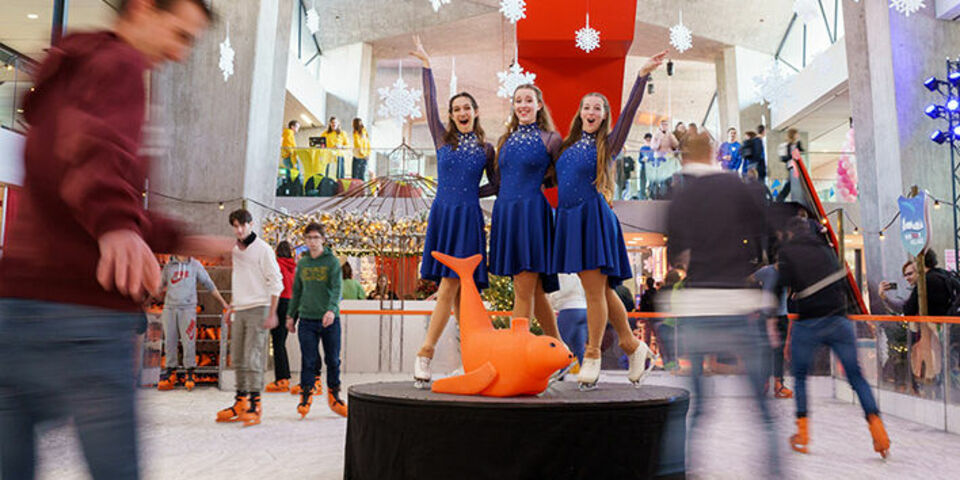An ice rink in Atlas, a responsible choice?
In festive style, with a dance show on the ice and a concert by Vokollage, the WinTU/er Village was opened during today's lunch break. From now through December 20th you can visit the Christmas fair on the ground floor of the Atlas building. There's plenty to see. Christmas trees in every corner, a market square full of picnic tables, stalls selling pea and sausage soup and other winter food and ... an ice rink. The rink is probably the biggest talking point of this year's fair. After all, an indoor ice rink, doesn't that guzzle power?
This isn't the first time the WinTU/er Village has featured skating. There was a rink in 2018 and 2019. Like the rest of the Christmas fair back then, these rinks were outdoors. “The skating was really popular, among students and employees, Dutch and internationals alike. It'd be true to say that the ice rink brought our whole community together,” says Erik de Jong, Community Manager at TU/e. In 2020, during corona, it was decided that in future the Christmas fair would be held indoors. “That made us really keen to move the ice rink indoors as well.”
Energy consumption
“Should we be doing this? That's the first question we asked ourselves,” De Jong tells Cursor. An ice rink inside a heated building can't help but raise questions about sustainability. “The most important question was how much power does a rink like this consume, and how can we keep that figure as low was possible?” Exactly how much power we are talking about is shown on an info board at the rink's entrance. For a two-week period, while the Christmas fair is being held, the counter stands at between 4860 and 6480 kWh. A household of four to six people consumes a similar amount in a year. This make the rink's energy consumption seem immense. But just consider this: if you had set up a stage with lights and sound, instead of an ice rink, the amount of energy consumed would be about the same. Still, De Jong understands why the ice rink raises more questions about sustainability than a stage would. “It seems to jar with common sense: you're putting something cold in a warm environment. Surely it's going to guzzle power. In actual fact, relatively speaking, the numbers aren't bad at all.”
Careful consideration
What's more, this year's ice rink consumes less energy than those of previous years, the outdoor rinks. This is because more sustainability measures have been taken. “It's not something you do lightly, put your ice rink indoors. A lot of thought goes into the decision,” says De Jong. “To translate a Dutch saying literally, we didn't skate over ice that's been frozen for just one night, meaning we didn't rush into this.” It seems paradoxical, but there are some intrinsic benefits to installing an ice rink indoors. Simply not having any sun, wind and temperature differences, for example, saves a lot of energy. In a constant environment there's no need to keep dropping the temperature to below freezing because the sun has melted the surface or the wind has blown a hole in the ice. Not only that, this year's rink is 30 percent smaller and has added insulation, the surrounding boarding has been designed to hold in the cold like a freezer, and an energy-efficient supplier has been chosen. The latter decision paves the way for an energy saving of no less than 40 percent. On top of all this, TU/e is purchasing all the necessary electricity from renewable sources and is reimbursing the supplier not only for the electricity but also for the emissions due to transport and construction.
So, is this ice rink a responsible choice?De Jong thinks it is. “We've seen how incredibly important it is to create moments that bring people together, enable them to meet, in an enjoyable way,” he says. “It's right to ask the energy questions, and you really should. And in response we can say that the energy consumption is manageable and, what's more, the energy can be sourced sustainably. Having this knowledge allows you to choose to do something like this.”
The main photo shows members of the Netherlands Figure Skating Academy during the official opening of WinTU/er Village.
The ice rink is open every day from now through December 20th, from 11 AM to 7 PM in Atlas. To ensure the best use is made of the rink, children from local primary schools will come along and skate every weekday morning from 10 to 11 AM.


Discussion